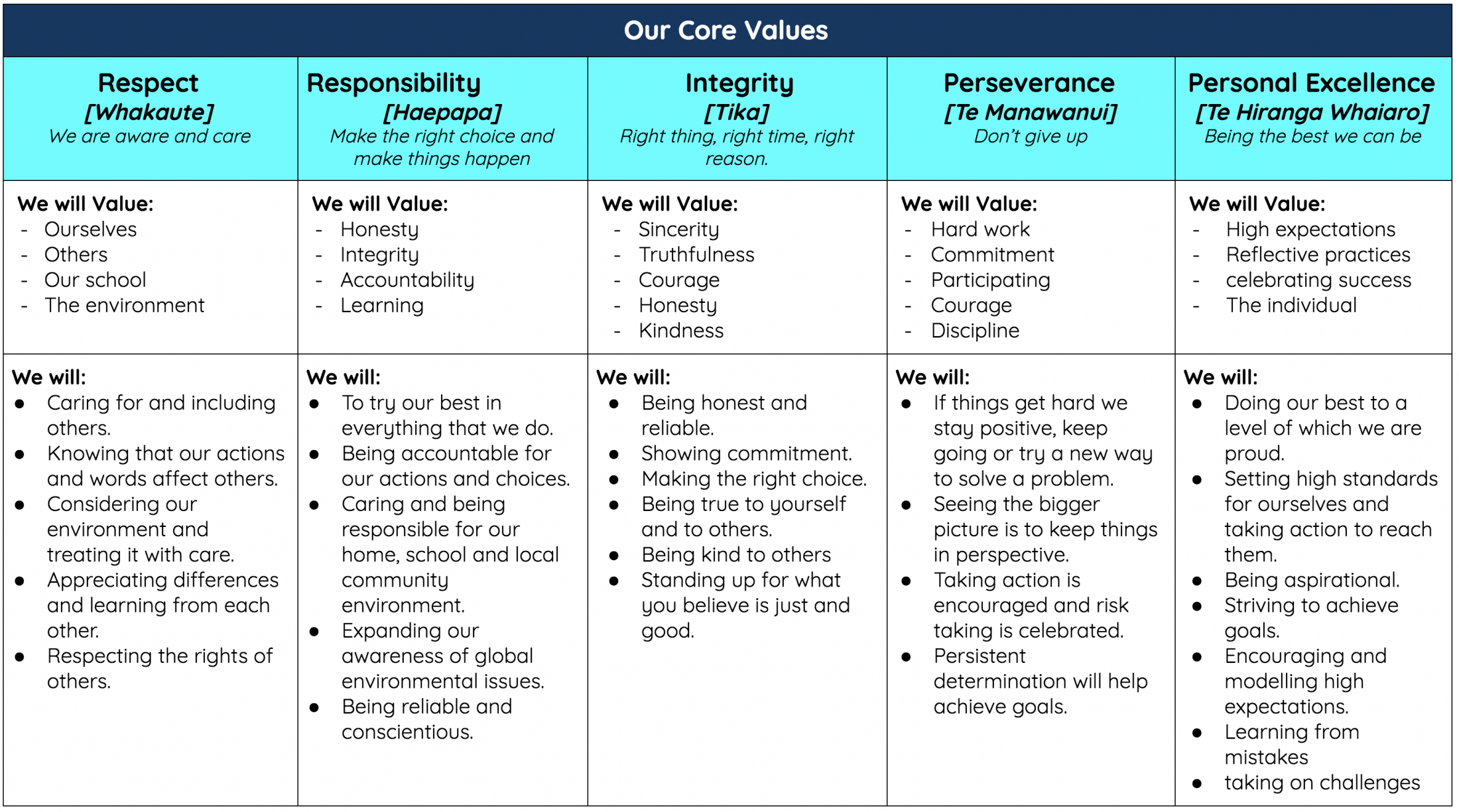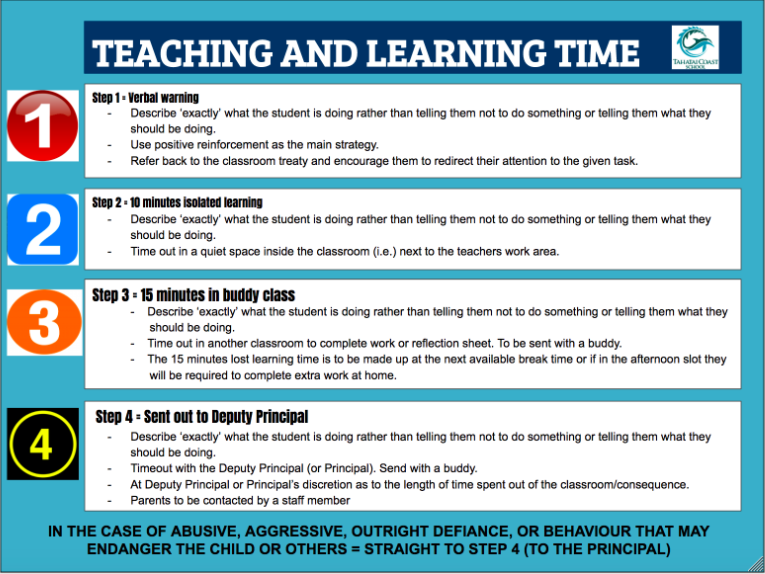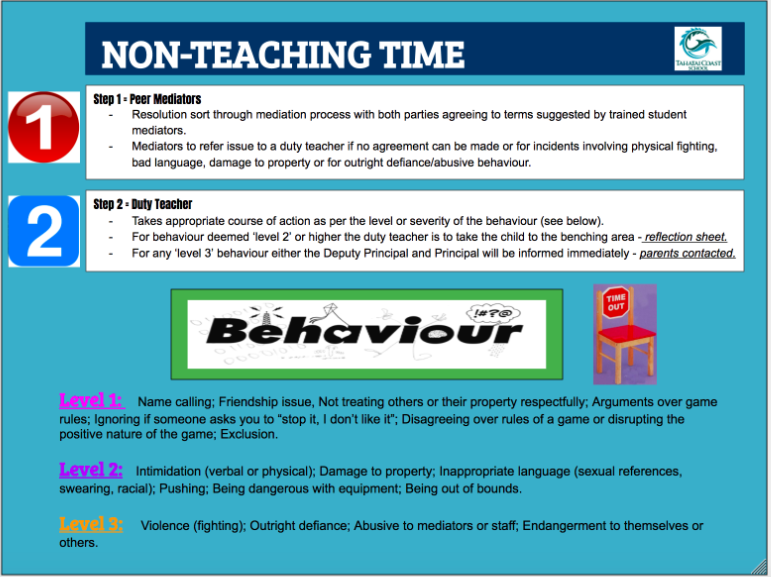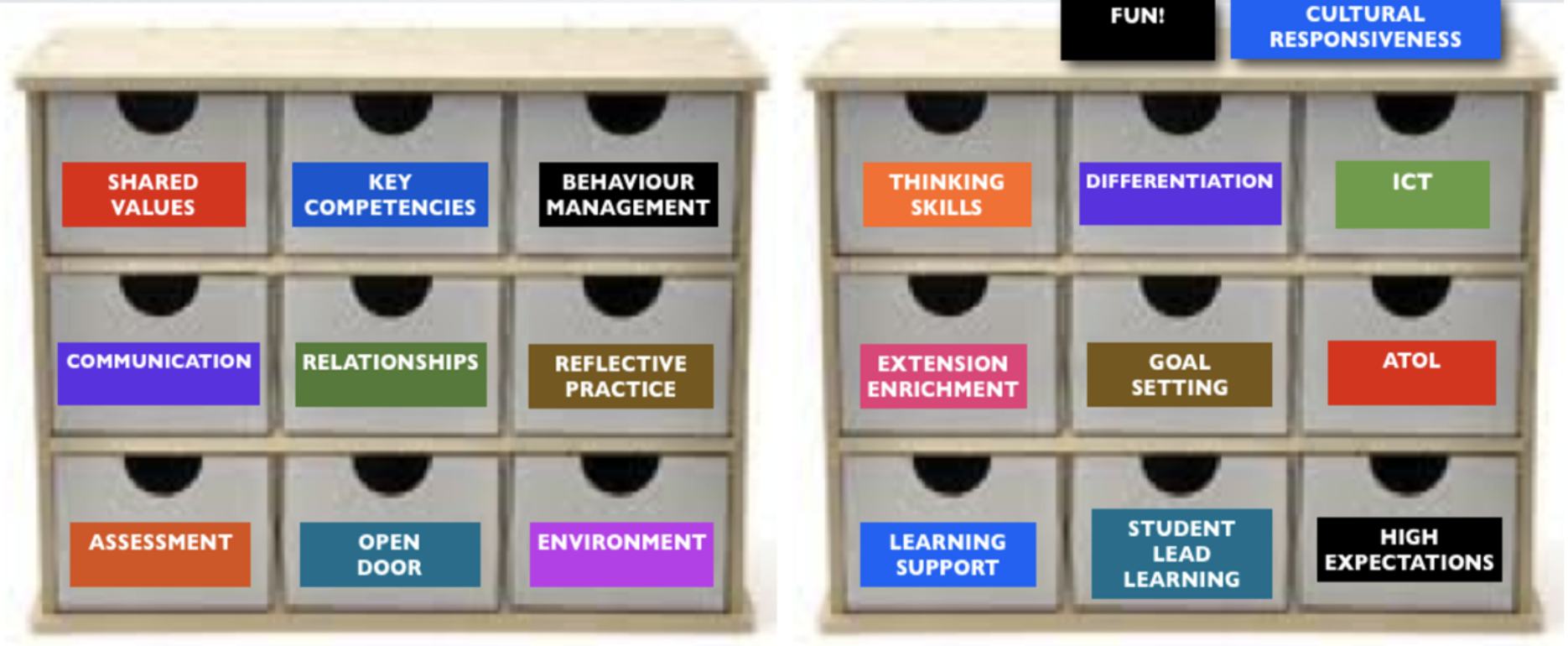Behaviour Management
“Promoting positive behaviours and attitudes towards learning”
Tahatai Coast School is a place where positive behaviours and attitudes towards learning are achieved through a school-wide approach. The Tahatai Coast School Values programme aims to ensure the school’s culture is one where:
- Positive behaviour and learning thrive.
- Students feel safe and love coming to school
- Differences and diversity are celebrated
Students will be taught in very specific terms what behaviours are expected of them so that there is a consistent response to these ‘desired’ behaviours across the school. The school-wide values approach focuses less on the individual students as the problem and more on changing the environment around them to support positive behaviours (preventative vs reactionary). It is a customised approach designed to fit the specific cultural and learning needs of every student.
The purpose is to focus on:
- Preventing problem behaviours from occurring.
- Developing students’ social skills.
- Reinforcing desired behaviours.
- Consistently addressing and reducing inappropriate behaviours.
- Using database assessment and problem solving to address concerns.
We achieve this through:
- Strong, visible leadership and commitment from the Principal, the leadership teams and Board of Trustees.
- Ongoing consultation and engagement with teachers and support staff, as well as the wider school community and whānau.
- Utilising ETap (our SMS system) to track incidents and produce reports. This is to ensure decisions are well informed/grounded in evidence, and so progress over time can be tracked.
- Positively stating clear and concise expectations for all students and staff. To be regularly reinforced and encouraged (through a blend of both intrinsic and extrinsic motivators).
- Teachers will ensure consistency across the school in the explaining, modelling, practising and acknowledging.
- A clear set of logical procedural steps to discourage and manage problem behaviour.
CODE OF BEHAVIOUR
Everyone at Tahatai Coast School (staff, students and parents) is expected to act in accordance to the school’s core values. All expectations for behaviour fall under the umbrella of the Tahatai Coast School values identified in the charter. It is an expectation that children and adults will behave with:

PREVENTATIVE STRATEGIES
- ENVIRONMENT: Learning environments will be safe, secure, informative, visually stimulating, colourful and reflective of student work - an environment that creates connections and a true sense of belonging. Teachers will ensure environments are well organised and encourage student participation and voice in the ongoing care and presentation of their classroom. Each classroom is to co-construct a ‘behaviour treaty’ with students, establish clear routines and regularly share expectations.
- RELATIONSHIPS: Building of relational trust between teacher-student and student-student (as well as with whanau/parents). Through shared values, teachers modelling learning (AKO) and empathy, being readily available, following up with promises, regular encouragement to build self-esteem and where humour is used to create a sense of fun and enjoyment. Relationships are to be fostered through honesty, support and the regular celebration of success.
- LEARNING FOCUSED: Programmes are informed through reflective practices and assessments and cater for individual student learning and cultural needs. Teachers embrace differentiated learning strategies, encourage students to take greater ownership of their learning (building levels of learner agency), and promote high expectations. The 6 We Live and We Learn behaviours (Competencies) are integrated into all areas of learning. Programmes are designed to engage, excite and promote higher order thinking.
- REWARDS: Positive praise recognizing progress and achievement against each of the school’s values and the We Live and We Learn behaviours will be part of everyday life at Tahatai Coast School. All staff will continue to reinforce desired behaviours by timely feedback, positive interactions and consistent recognition.
To ensure consistency in learning environments across all areas of the school classrooms will ensure the following are implemented/applied:
A TCS CLASSROOM’S ESSENTIAL LIST Evidence tells us students learn best when teachers:
|
NB: The above shows the TCS Essential List of ingredients that promote positive learning experiences for all. |
POSITIVE REINFORCEMENT
Acknowledgements of positive attitudes and behaviours will be part of everyday life as a means to promote and recognise examples and modelling of desirable behaviours.
CONSEQUENCES
Behavioural consequences are used as the link between rights and rules, and subsequent accountability. Consequences are to be fair and reasonable in relation to the degree of seriousness of the behaviour. They are to be applied with fairness and respectfully and to be used as a tool to ‘teach’ the student that all behaviours have consequences.
Rules in Class | Rules out of class |
| We speak kindly and respectfully. | TALKING | We speak kindly and respectfully to each other. |
|---|---|---|
| We work quietly and helpfully together. We take turns. | LEARNING | We co-operate with others. We share the playground and learning resources. |
| We walk quietly in our room and put things away carefully. | MOVEMENT | We take care when we are moving about or playing outside. We look after our equipment. |
| We are kind to each other and use good manners. | TREATMENT | We are kind to each other. We play friendly games. |
| We try to solve problems in a fair manner. If that is hard, we ask a teacher for help. | PROBLEM SOLVING | We talk to each other and try to work problems out. If we need help we ask a peer mediator or teacher. |
| We try not to hurt people. We use equipment safely. | SAFETY | We play safe games. We play in safe areas of the playground. |
NB: TEACHERS TO USE THIS AS A GUIDE ONLY WHEN CO-CONSTRUCTING THEIR CLASSROOM BEHAVIOUR TREATY. |
TEACHING AND LEARNING TIME/NON-TEACHING TIME BEHAVIOUR CHARTS
 |  |
COMMUNICATION
Teachers are not to raise their voices in anger to students. If situations lead to frustration the teacher is to feel confident in following the steps outlined in either ‘Teaching’ or ‘Non-Teaching’ procedures above. Communication between the home and school is vital when dealing with serious behaviours such as:
- Violence
- Aggressive or abusive behaviour
- Theft
- Safety is compromised
- Bullying
Or when there is concern that interventions are not redirecting inappropriate behaviours. This is best communicated face-to-face or by phone.
Teachers on duty will be responsible for reporting all serious misbehaviours to someone from the leadership team (Principal, DP or AP) and may be asked to enter the issue onto ETaP. This will record the date, name and behaviour.

